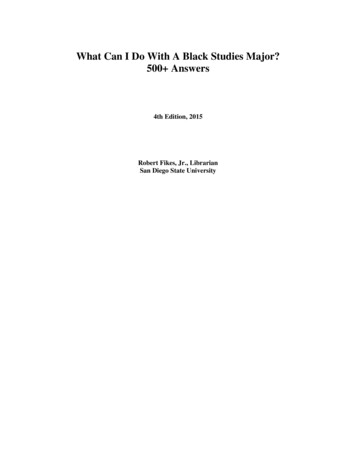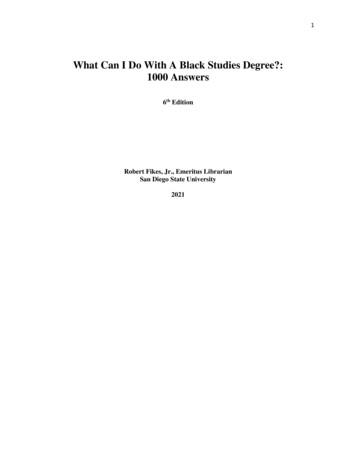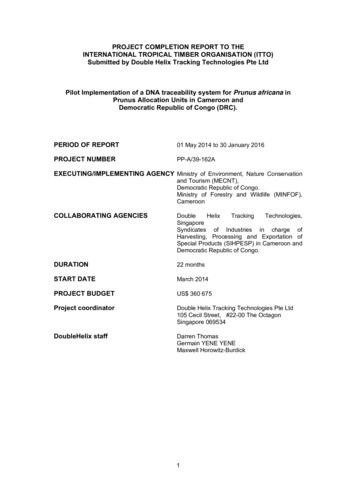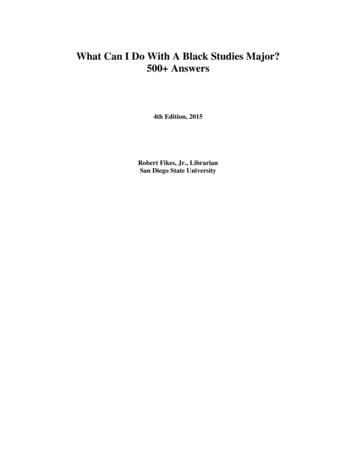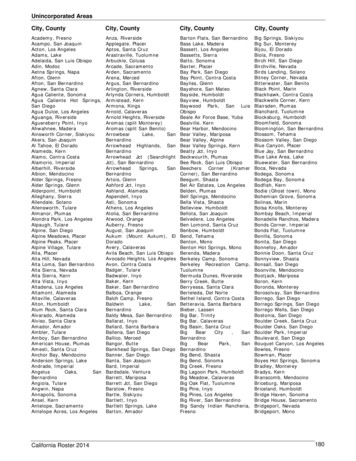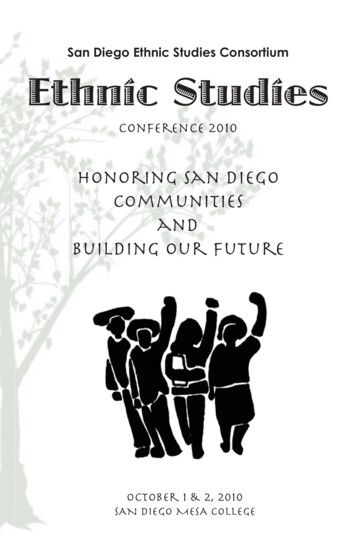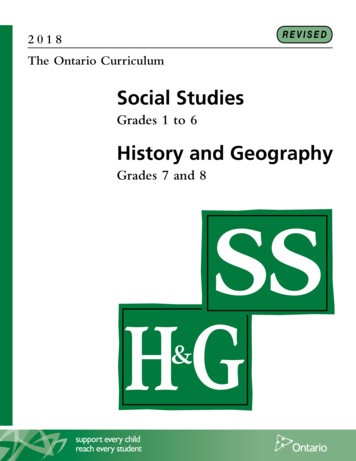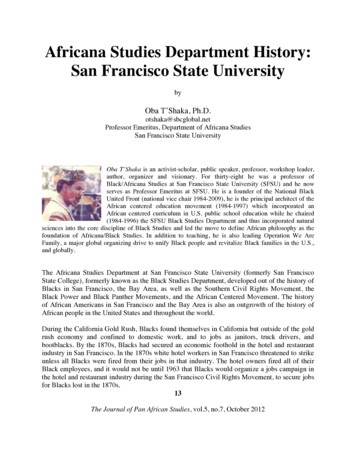
Transcription
Africana Studies Department History:San Francisco State UniversitybyOba T’Shaka, Ph.D.otshaka@sbcglobal.netProfessor Emeritus, Department of Africana StudiesSan Francisco State UniversityOba T’Shaka is an activist-scholar, public speaker, professor, workshop leader,author, organizer and visionary. For thirty-eight he was a professor ofBlack/Africana Studies at San Francisco State University (SFSU) and he nowserves as Professor Emeritus at SFSU. He is a founder of the National BlackUnited Front (national vice chair 1984-2009), he is the principal architect of theAfrican centered education movement (1984-1997) which incorporated anAfrican centered curriculum in U.S. public school education while he chaired(1984-1996) the SFSU Black Studies Department and thus incorporated naturalsciences into the core discipline of Black Studies and led the move to define African philosophy as thefoundation of Africana/Black Studies. In addition to teaching, he is also leading Operation We AreFamily, a major global organizing drive to unify Black people and revitalize Black families in the U.S.,and globally.The Africana Studies Department at San Francisco State University (formerly San FranciscoState College), formerly known as the Black Studies Department, developed out of the history ofBlacks in San Francisco, the Bay Area, as well as the Southern Civil Rights Movement, theBlack Power and Black Panther Movements, and the African Centered Movement. The historyof African Americans in San Francisco and the Bay Area is also an outgrowth of the history ofAfrican people in the United States and throughout the world.During the California Gold Rush, Blacks found themselves in California but outside of the goldrush economy and confined to domestic work, and to jobs as janitors, truck drivers, andbootblacks. By the 1870s, Blacks had secured an economic foothold in the hotel and restaurantindustry in San Francisco. In the 1870s white hotel workers in San Francisco threatened to strikeunless all Blacks were fired from their jobs in that industry. The hotel owners fired all of theirBlack employees, and it would not be until 1963 that Blacks would organize a jobs campaign inthe hotel and restaurant industry during the San Francisco Civil Rights Movement, to secure jobsfor Blacks lost in the 1870s.13The Journal of Pan African Studies, vol.5, no.7, October 2012
Julian Richardson, co-owner of Marcus Bookstore, observed that although Blacks in SanFrancisco were confined to menial jobs prior to World War II, “Blacks had a flair in whateverjobs we performed downtown.” In the thirties Joe Shrives was a doorman at a downtown hotel.The dignified way Joe carried himself on the job made wealthy whites “fight for his attention.”Walter Sanford, an African American was hired as a janitor in City Hall, however, he nevertouched a broom. He served as the official greeter for many San Francisco mayors. He alsobecame an investor in Trans Bay Savings and Loan. While the Black population in San Franciscowas small prior to World War II, African Americans played a leading role in the City’sdevelopment. William Leidersdorff, an African American, captained the first steamship to enterSan Francisco Bay. He also built and owned the City’s first hotel, while holding several key civicjobs including Treasurer of San Francisco. Anti-slavery activist, Mary Ellen Pleasant, wasregarded as the Mother of Civil Rights; this courageous Black woman provided the financing forJohn Brown’s armed uprising; she also used part of her wealth to free Blacks from slavery.Don’t Buy Where You Can’t Work, Job CampaignThe Black population in San Francisco remained small until World War II. In 1910, there were1,642 Blacks living in San Francisco, with the number increasing to 4,000 by 1940. During thewar the Black population in San Francisco increased to 40,000. When the Japanese Americanpopulation in California and San Francisco was placed in concentration camps, Blacks beganmoving into the Fillmore district and into the Western Addition. In a few cases, Blacks held ontoJapanese property during their concentration camp internment, returning the property to Japaneseownership at the end of the war. As newly arrived occupants of the Fillmore, Blacks could notrent store space because whites controlled the property. In 1944, Chinese American merchantsset up small businesses in the Fillmore, selling quality food at a cheaper price than the whitemerchants. This Chinese business strategy drove the white businesses of the Fillmore.By 1946, Blacks could purchase goods in stores located in the Fillmore, (which also includedSinger Sewing Machine Company and other downtown businesses) but they could not work inthese stores. These conditions generated a “jobs movement” for Blacks in the Fillmore. In the1930s, a Black Nationalist, Sufi Muhammad, had launched a “don’t buy where you can’t work”jobs campaign in Chicago’s Black communities.This campaign spread to Harlem in the 1930s under the leadership of Adam Clayton Powell. In1946, the “don’t buy where you can’t work” job campaign spread to the Fillmore under theleadership of Charles Augustus. This campaign had the support of some Black churchesincluding Third Baptist Church, and it had the support of Dr. Carlton Goodlett, medical doctorand owner of the Sun Reporter newspaper. This job campaign produced jobs for Blacks at theFillmore branch of the Bank of America, and in businesses located in the Fillmore. Thecampaign was a forerunner of the San Francisco Civil Rights Movement.14The Journal of Pan African Studies, vol.5, no.7, October 2012
The San Francisco Civil Rights MovementWith the end of World War II, Blacks in San Francisco lost most of the jobs theyheld during the War. Shipyard jobs evaporated, and whites returning from the warreplaced Blacks in many other jobs, leading to the Black unemployment rate risingto 30%. Once again Blacks were confined to nineteenth-century occupations asdomestics, bootblacks, postal workers, longshoremen, and a few streetcar drivers.With the exception of ILWU (International Longshoremen and WarehousemenUnion) jobs, union jobs were closed to Blacks, and Blacks and people of color were invisible inthe downtown economy. In the area of housing, as many as nine, ten, and fifteen people werecrowded into a single room.The San Francisco Civil Rights Movement, which grew out of these dire economic conditions,was inspired by the Southern Civil Rights Movement, the Cuban Revolution, and the AfricanIndependence Movement. In 1960, Bob Slattery and Ella Hill Hutch formed the San Franciscobranch of the Congress on Racial Equality (CORE). Ella Hill Hutch became the Mother of theSan Francisco Civil Rights Movement and went on to become the first Black woman elected tothe San Francisco Board of Supervisors.From 1961 to 1963, Wil Ussery served as Chair of the San Francisco CORE. He later served asNational Action Council vice chair and NAC Chair, the highest policy-making position inNational CORE. Ussery led campaigns for quality education for Black youth and all youth ofcolor.The local chapter of the NAACP was led by Dr. Nathanial Burbridge, one of only four militantNAACP heads in the sixties, Dr. Burbridge held two PhDs, one in pharmacology and the other inmedicine. The San Francisco NAACP under Burbridge’s leadership would serve as a close allyof San Francisco CORE even though it faced opposition from the national office of the NAACPbecause it sided with grassroots Blacks in mass struggles for jobs.In 1963, Bill Bradley (now Oba T’Shaka) was elected Chair of San Francisco CORE. Accordingto an article May 2, 1964, in the Sun Reporter, CORE leadership and membership considereditself “responsible to what we consider the best interests of the Black community. Thisdetermination is based upon discussions among Blacks found in barbershops, beauty shops,poolrooms, restaurants, churches, and through organizing on the streets The organization (CORE) has developed courage which has made it immune to biasedcriticism.” San Francisco CORE’s central strength was that neither the white power structure,nor the Black elite had any control over the organization. CORE proved to be sell-out proof, andtotally dedicated to the liberation of Black people and people of color. They were also smart: inthe course of the San Francisco Civil Rights Movement they fought the economic powerstructure of San Francisco for jobs for Blacks and people of color because in their discussionswith the Black grassroots, over and over again, Black folks said they needed jobs.15The Journal of Pan African Studies, vol.5, no.7, October 2012
In 1963, San Francisco CORE reached 260 job agreements with major San Francisco employers.According to the 1964 Corelator, the newsletter of San Francisco CORE, the organizationreached 375 additional job agreements with major downtown employers on behalf of Blacks andall people of color. These job agreements were reached with industry leaders, hence forcingliterally thousands of employers to provide additional jobs. The 1963 Birmingham campaign ledby Dr. Martin Luther King’s organization SCLC (Southern Christian Leadership Conference),sparked greater momentum at the local level, leading to the formation of the United FreedomMovement, a Black United Front formed in San Francisco.In 1963, San Francisco CORE, under T’Shaka’s leadership, led a Christmas boycott campaignagainst JC Penny’s and Macys. This successful campaign opened up jobs for Blacks and peopleof color in all of the major downtown department stores. In 1964, San Francisco CORE initiateda jobs campaign against Lucky Supermarket throughout the Bay Area. A large number of jobswere gained through this campaign. In fact, Lucky Supermarkets were compelled by SanFrancisco CORE to hire only Blacks and people of color for one year and an equitable number ofBlacks and people of color thereafter. In 1964, the UFM (United Federation Movement) selectedthree major employment campaigns. One was the Sheraton Palace Hotel, and the hotel andrestaurant industry, under the leadership of an Ad Hoc Committee, led by Tracy Sims, a formerSFSU student. The second jobs campaign was against Auto Row, under the leadership of the SanFrancisco NAACP. The third campaign was launched statewide against the Bank of America,then the largest bank in the world. The Bank of America job campaign was under the leadershipof San Francisco CORE and its head, Oba T’Shaka. After a six month campaign (three months ofnegotiations and three months of demonstrations) CORE succeeded in defeating the Bank ofAmerica, and this defeat led the other banks to hire substantial numbers of Blacks and people ofcolor.These three job campaigns put 10,000 people in the street, making it the largest Northern CivilRights Movement, and the most effective. Between 1960 and 1965 San Francisco COREdefeated the entire economic power structure, never losing a battle for jobs. The San FranciscoCivil Rights Movement was the Mother Movement in the San Francisco Bay Area. Becausemany of the shock troops that took part in job demonstrations for over a year were University ofCalifornia/Berkeley students, their radicalization inspired them to launch the Free SpeechMovement. The San Francisco Civil Rights Movement gave birth to the Free Speech Movement.SFSU activists, who took part in the San Francisco Civil Rights Movement’s Auto Rowcampaign, planned the San Francisco State Tutorial Program for Black youth in the Fillmore, ina jail cell, where they were arrested in the Auto Row sit-in. Lessons learned by these largelywhite students inspired them to form the Experimental College where students were able to teachSan Francisco State courses designed by students. The San Francisco Civil Rights Movementpreceded the Black Panther Party, and provided inspiration to the Negro Student Association,and the Black Students Union, which led to the San Francisco State Strike.16The Journal of Pan African Studies, vol.5, no.7, October 2012
The San Francisco State Strike and the Birth of Black StudiesIn 1963 Black Nationalism began to rise up inside San Francisco CORE, and by 1965 SanFrancisco CORE represented the leading arm for Black Nationalism within National CORE. In1963, the Negro Student’s Association (NSA) was formed at San Francisco State University.Between 1963 and 1968 the NSA had two ideological currents: one favored integration and theother favored Black Nationalism. The Black Nationalists wing of the NSA was influenced by thethoughts of Malcolm X, Marcus Garvey, the Afro-American Association and the emerging BlackNationalist thrust of the San Francisco Civil Rights Movement.The Black Nationalist outlook of the NSA was reflected in that organization’s constitution thatcalled for it to:Engage in projects that the membership considers to be in the interest of the Negro community;to engage in the study of Negro history and life; to foster growth and dissemination of Negrocultural contris butions. (The San Francisco State Strike, pg. 16)Key NSA Black Nationalist-oriented members, such as Aubrey La Brie, Huey LaBrie, JoeGoncalves (Brother Dingane, a leader in San Francisco CORE), Abdul Karim, and Marc Primus,became leaders of the Black Arts Movement, and with the exception of Marc Primus theyfounded a leading Black Cultural Arts magazine, Black Dialogue. Later, Joe Goncalves foundedthe Journal of Black Poetry another instrumental arm of the Black Arts Movement.Black Dialogue was important because it combined a Black Nationalist political analysis offundamental issues arising out of the Civil Rights Movement, with a cultural analysis concernedwith the position of Black Art, Black Poetry and Black Performing Arts. In the 1965 issue ofBlack Dialogue, Leroi Jones, wrote on the “Revolutionary Theatre,” while Edward Spriggs wrotean article entitled “Negritude Americaine.” This article provided a background for the NegritudeMovement stressing the need for “(a) Negro culture patterns (to) be first interpreted by Negroes,and (b) that they express the inner life of Black people in its reality.” (Black Dialogue, pg. 8) Anarticle written by T’Shaka analyzed the San Francisco Civil Rights Movement. The article notedthat while the Southern Civil Rights Movement was the inspirational force for the Northern CivilRights Movement, increasingly the Northern Civil Rights Movement was becoming morenationalistic. Lessons learned in the battle against institutional racism along with lessons learnedfrom the Nation of Islam and Malcolm X was having a profound impact on the Civil RightsMovement in the North.Similarly, the non-compromising nature of the San Francisco Civil Rights Movement, and itseffectiveness in defeating the white economic power structure, made a strong psychological andpolitical impact on the emerging generation of Black youth in the Bay Area, who would make upthe leadership core of the San Francisco State Strike.17The Journal of Pan African Studies, vol.5, no.7, October 2012
This emerging leadership group was inspired to see the San Francisco, Rights Movement defenda position in front of the white power structure and not bow down. This articulateness, alongwith the successful use of boycotts, picketing, etc., techniques also employed in the South,prompted this emerging Black youth leadership to an action orientation.By 1965, the Civil Rights Movement was transforming into a Black Nationalists Movement, andBlack youth leadership found itself increasingly influenced by the spirit and thoughts ofMalcolm X and Frantz Fanon. According to Benny Stewart, former Chairman of San FranciscoState’s Black Student Union, “when we look at King we see that he was a spark. King broughtout the contradiction. King came up with a methodology or approach with a minimum ofcausalities. However, Malcolm was the Spirit. From Malcolm we learned to demand what wewanted, to take no jive, and go get it.” (Journal of Black Studies, 1982, pg. 16) Malcolm X alsoprovided a theoretical thrust, which called for Black people to unify. His Organization of AfroAmerican Unity was a forerunner of positive Black organizations.Between 1963 and 1966 the Negro Students Association recognized that student government wasnot acting in their interests so they formed an alliance with a conservative slate of candidates;when this failed they formed an alliance with a liberal slate; after this there was a period of workin the Black community. During the latter phase the issue of fighting redevelopment in the Blackcommunity was the primary thrust. The next phase was the African arts and culture phase.” (ibid.pg. 15)A never before revealed incident occurred in 1964 while Malcolm X was traveling on theAfrican continent and meeting with African and Arab heads of state. During this trip, Malcolmmet Dr. Pauula Kamarakafego and informed him that he and Adam Clayton Powell planned tocall a Black Power Conference in the United States. Malcolm was assassinated before thisconference could be called. Instead when the major Civil Rights groups continued JamesMeredith’s March Against Fear in Mississippi, Willie Ricks (Mukasa Dada) a participant inAdam Clayton Powell’s Black Power Conference, encouraged Stokeley Carmichael (KwameTure) to call for Black Power. With the call for Black Power by SNCC’s leader, the movemententered the Black Power phase.Black youth and Black people in general were given a new sense of strength and vigor when theslogan “Black Power” was announced in 1966. All of these struggles (Civil Rights, BlackNationalism, Urban Rebellions, Black Panthers, US organization and Black Power) helped createan atmosphere that encouraged struggle––in the Black community and among Black students onthe college campus.18The Journal of Pan African Studies, vol.5, no.7, October 2012
Black Power, and the previous struggles of Black people, helped create an ethic of Blacks beingresponsible to Blacks. For Black students, this meant that they should be concerned about theiridentity, and about using their skills for the benefit of the Black community.This atmosphere made it possible in 1966 for Jimmy Garrett and other nationalists in the NegroStudents Association to push to change the name to the Black Students Union. In pushing for thename change, Black students had to choose between the name Black Students Union, or AfroAmerican Association. The Black Students Union was chosen; it laid stress on Black, and beingBlack was the big issue. When the name was changed, the integrationists left.The most important aspect of the entire process leading up to the San Francisco State Strike wasthat a new type of Black person and Black student was being born. He/she was being born out ofhis/her community struggles, and they were being born out of their trial and error strugglesagainst institutional racism on a white-dominated San Francisco State University campus.As Black students on campus increasingly began to confront racism, they gained “a confidenceto run things.” (Nathan Hare) According to Dr. Hare, on arriving at San Francisco State, thething that struck him as being extremely significant was that “Black students had an amazingsense of self-confidence in their ability to run things.” (ibid. pg. 17) In Benny Stewart’s words:“At San Francisco State you had well read, well informed Black students. They were replicas ofMalcolm X and Donald Warden [now Khalid Abdullah Tariq al-Mansour]. They could arguetheir point of view against anybody.” (ibid. pg. 17)As the Black Student Union began to grow from 12 to 400 members, the Board of Trusteesdeveloped new SAT (Scholastic Aptitude Test) requirements. Students applying for admissionsto state colleges had to score in the top third of their graduating class. This worked to reduce thenumber of Black students admitted to state colleges. By 1965 and 1966 the Black student bodywas reduced from ten percent to four percent. The admission of more Black students was anecessity.19The Journal of Pan African Studies, vol.5, no.7, October 2012
At the same time, Black students at San Francisco State were a minority on a white racistcampus. The opposition between Black students and white racism on campus created anawareness among Black students of the need for Black Studies courses that could serve as acounter to white value and white attitudinal courses. BlackStudies courses were needed to create counter images tothose white value-oriented courses, while providing arigorous intellectual curriculum rooted in the Black cultural,political, economic, literary, social, psychological, andhistorical reality.The Black Students Union (BSU) began a multi-facetedorganizing campaign that would provide the foundation forthe Black Studies strike. First, Black students introducedBlack history courses through the Experimental College,employing Leroi Jones (now Amiri Baraka), Sonia Sanchez,and Mary Lewis as instructors. The BSU proceeded to analyze the power structure and socialstructure at SFSU. The BSU concluded that the office of college president and vice presidentwere servants of the California State University trustees. Black Students at SFSU were analyzedand found to consist of different social groups. Each grouping was conceived to play a specificrole in the strike. The Black Nationalists coming out of the BSU were the leaders among Blackstudents, and they would become the leaders of students-at-large at SFSU.The Black Nationalists on campus worked with the Black Fraternities and Black Sororities.Given the social role of the fraternities and sororities, they were assigned the task of organizingparties for the BSU. The majority of Black students on campus were regular students who werethe main victims of the restrictive admissions programs on campus. They would be the mainbeneficiaries of open admission for Black students. Regular students represented the backbone ofthe BSU, and they were the main support group for the strike. The Black athletes were alsoreached. When the BSU approached the athletes for support they discovered that they wereintimidated by their coaches. When the athletes saw Black Students Union members stand up tothe coaches, they began to realize that the coaches were not gods. When the strike occurred, theathletes supported the strike by refusing to play. There was no football played during the strike.Sisters in the BSU were placed into paying jobs in each school on campus. Sisters used thesepositions to keep the BSU informed on the moves that were being made by different departmentson campus.The BSU didn’t confine their organizing to Black students. The BSU analyzed the role of thewhite left on campus and determined that they based the bulk of organizing on Black issues andopposition to the war in Vietnam. The BSU gained control and direction of the white “left” bycreating relationships with their leadership and giving them marching orders. The BSU alsoexploited the attitude of white guilt over white racism that the white left had.20The Journal of Pan African Studies, vol.5, no.7, October 2012
In approaching the Third World groups, the BSU had the advantage of having a higher level ofpolitical consciousness. So the BSU provided the lead that Third World students followed. TheThird World groups were the only ones to be able to attach their demands for an Ethnic StudiesDepartment, and a College of Ethnic Studies, onto the BSU demands for a Department of BlackStudies.The Black Students Union gained control of the Tutorial program, placing 250 Black studentsinto tutorial positions previously held by white students. As Black students began to see the needfor a Black Studies Department, they began to apply pressure to the San Francisco Stateadministration to hire a Black Studies Department head. When Dr. Nathan Hare came to speak atthe American Sociological Association in San Francisco, Jimmy Garrett asked him to head theBlack Studies Department. After considering the offer, Hare decided to accept the position. Dr.Hare was an excellent choice for Department Head of the first Black Studies Department in afour-year college. Dr. Hare was E. Franklin Frazier’s best student, and he came to SFSU wellequipped to establish the Black Studies curriculum.The period from 1967 to 1968 was a period of rising influence of the Black Panther Party inBlack communities throughout the United States. The BSU during 1967-68 had the backing andmoral support of the Black Panther Party. Also they could only organize it with the backing ofthe Black community. The Black Panther Party was the most advanced organizational force inthe Black community and the Panthers were supportive of the strike. Being supportive of theBSU and the strike didn’t mean that the BPP exercised control of the Black Students Union. TheBPP understood the students as self-generating.By 1968 Black students at SFSU were reaching a point where a strike was the only alternative toadministrative delays and compromises. With the hiring of Dr. Hare, the BSU was demanding anindependent Department of Black Studies. Under such a department, Blacks could determinewhat courses would be taught and which professors would teach. When it became clear that theadministration would only offer 2.5 teaching positions the BSU had no choice. They had to callfor a strike.The Black Students Union put forward ten demands and the Third World Liberation Front addedan additional five demands. The ten demands of the BSU were:1. All Black Studies courses being taught through various other departments be immediately partof the Black Studies Department and that all instructors in this department have full time pay.2. Dr. Hare, chairman of the Black Studies Department, receive a full professorship and acomparable salary according to his qualifications.21The Journal of Pan African Studies, vol.5, no.7, October 2012
3. There will be a Department of Black Studies which will grant a Bachelor’s Degree in BlackStudies; that the Black Studies Department chairman, faculty and staff have the sole power tohire and fire without the interference of the racist administration and the chancellor.4. All unused slots for Black students from fall 1968 under the Special Admissions Program befilled in spring 1969.5. All Black students who wish to, be admitted in fall 1969.6. Twenty full-time teaching positions to be allocated to the Department of Black Studies.7. Dr. Helen Bedesem be replaced in the position of Financial Aid officer and that a Blackperson be hired to direct it and that Third World people have the power to determine how it willbe administered.8. No disciplinary action will be administered in any way to any students, workers, teachers, oradministrators during and after the strike as a consequence of their participation in the strike.9. The California State College Trustees will not be allowed to dissolve any Black programs onor off the San Francisco State College campus.10. George Murray maintains his teaching position on the campus for the 1968-69 academicyear.Five Demands of the Third World Liberation Front1. Schools of ethnic studies for the ethnic groups in the Third World be set up, with students foreach particular organization having the authority and the control of the hiring and retention ofany faculty member, director, or administrator, as well as the curricula.2. Fifty faculty positions to be appropriated to the schools of ethnic studies, 20 of which wouldbe for the Black Studies Program.3. In the spring semester, the college fulfills its commitments to the nonwhite students inadmitting those that apply.4. In the fall 1969 semester, all applications of nonwhite students be accepted.5. George Murray and any other faculty members chosen by non-white people as their teachersbe retained in their positions.22The Journal of Pan African Studies, vol.5, no.7, October 2012
In calling the strike, the BSU, from the beginning, took the position that the 15 demands werenon-negotiable. In Benny Stewart’s words: “The demands were non-negotiable because that’swhat we wanted. We wanted twenty teachers and the rest of the fifteen points.” (ibid. pg. 21)The strike strategy the BSU adopted was the “War of the Flea.” This strategy was taken from abook written by Robert Taber entitled The War of the Flea. The strategy of the flea is the hitand-run strategy of guerilla warfare. The BSU saw the Black students adopting a hit-and-runstrategy. They recognized that police tactical squads (Tac) were being used all over the country.A hit-and-run strategy could avoid the brunt of the tactical squad’s violence. The goal of thestrike was “to stop the running of the college. Telling people that class was over, closed downthe college. By the time the Tac squad got there the class was over.” (ibid. pg. 21)During the course of the strike the Black and Third World studentswere joined by the AFT (American Federation of Teachers). The AFTdecided to use the strike to press for the adoption of their labordemands. The AFT purported to support the strike. In fact, they helpedto kill it. (ibid. pg. 22)By now, “hardnosed” S.I. Hayakawa had become president of SFSU.He was quickly becoming the favorite of the right wing, and the Board of Regents. One ofHayakawa’s close advisers was W. Clement Stone, a strong right-winger. Stone gave Hayakawa 100,000 and suggested that Hayakawa offer the strikers 11.3 professors instead of 20.Hayakawa made that offer, and he agreed to establish a Black Studies Department under theleadership of Dr. Hare and Joseph White the Black Dean of undergraduate studies. Hayakawaalso agreed to use the 128 unfilled special admission slots; although he didn’t say that ThirdWorld students would fill these slots. Finally he agreed to appoint a Third World associatedirector of financial aid “with specific decision-making responsibility in dealing with ThirdWorld students.” (Shut It Down: A College in Crisis, pg. 60)After discussing Hayakawa’s offer, the BSU central committee decided to accept his
San Francisco State University Oba T'Shaka is an activist-scholar, public speaker, professor, workshop leader, author, organizer and visionary. For thirty-eight he was a professor of Black/Africana Studies at San Francisco State University (SFSU) and he now serves as Professor Emeritus at SFSU. He is a founder of the National Black
